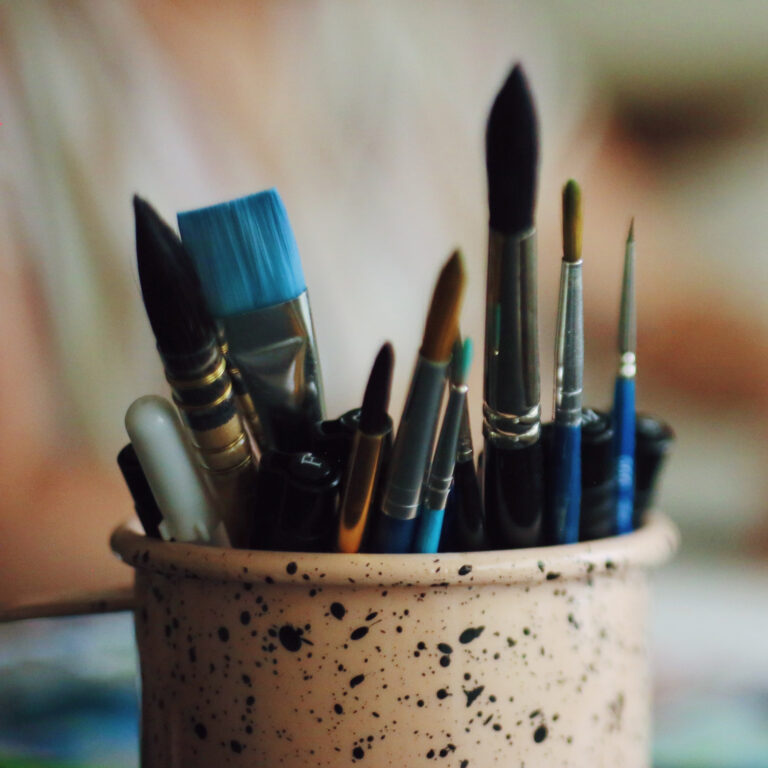In my first art teaching job, I took over for a man who failed to get tenure. His classes were out of control, and the state of the room was all the evidence one would need to know things weren’t working out. Running a well-kept art room is one of those things no one thinks about or credits you with until there is a problem.
So, how is your year going so far in terms of getting your students into good habits that lead to a well-maintained studio? I ask because now is the time to instill those habits that will carry through the entire year. One of the pieces of advice I carried with me throughout my career was, “When you feel overworked, that means the students aren’t doing enough.” This sentiment is never more true than when it comes to keeping an art room clean. Why should an art teacher spend their time after school scrubbing palettes or washing brushes? One great thing about teaching is that we don’t have to reinvent the wheel. Here is some sage advice on making cleaning the art studio manageable and teaching students accountability and responsibility.
1. You need cleaning supplies. Be sure your room is well stocked with cleaning supplies. Don’t be shy; approach your custodians and determine what they stock and what they can provide for you. Every school has different systems and policies. Often, custodians will treat the art program a little differently. For example, in my school, most teachers had to put in a work order for the custodian to come and refill the paper towel dispenser. The custodians and I worked out that they would give me multiple rolls at a time to keep under the sink and my own key to the paper towel dispenser so I could load it myself.
You will also need sponges, cleaning solutions, brooms and dustpans, maybe a mop, and wastebaskets. On the topic of wastebaskets, you will need more than one, and how many depends on the size of your room, but make them easily accessible for you and your students. Buckets and plastic gloves were other things I liked having on hand.
I don’t like to reach into my personal budget often, but at times, it was worth it to have exactly what I needed. For example, I purchased these thick car sponges for cleaning tables with my ceramic class. One year, as we embarked at the end of the year cleaning, I bought shaving cream at the request of my students. Indulging their nostalgic desire was well worth it because they dove in with getting their tables sparkling clean for the end of the year.
2. Model how to clean. At the beginning of a new project, stop the class early and review how to clean the materials. Assume they know nothing and model exactly how they need to clean the materials they are using. I also review lazy behaviors I don’t want to see. One of my favorite behaviors that I like to nip in the bud is lazy palette cleaning. Some students will rely on the stream of water to wash away all the paint. This is WRONG on so many levels, and I talk to them about being efficient time-wise and conserving water as well. I also stress at the BEGINNING of class not to take too much as it makes cleaning at the end harder. I teach my class to use one paper towel to scoop paint into the garbage and use a sponge and squirt of soap to clean actively.
Art teacher Molly Alvidrez uses a projector to show an image of what the tables should look like at the end of class. She writes, “I circle around during clean-up to ensure everyone is doing their share. It’s really helped a lot.”
3. Take ample time for cleaning. l always carve out time at the end of the class for cleaning. I used a sign with the time they could begin cleaning and the end time for the period that hung next to the class clock on the wall. Students weren’t allowed to clean up before their designated time without permission. A timer works well, too, and there are a lot of options. Many teachers simply set their smartphones with an alarm for the start of clean up. There are online tools you can set up and project like this one at Timeme.com (be aware there are ads). On the Timeme website, you can change the sounds, the number of times it rings, and the color. You can save your timers and keep it as a shortcut on your browser. Every morning, you can pull up the page, and the alarm rings when it is time, and you can project it on your smartboard. There is also nothing wrong with the old classic of an egg timer. You can use a kitchen timer like this one if you have longer blocks.
4. Make it a grade. Art teacher Lara Willard shared her system. I have a list of tasks on a clipboard, each assigned to a group of 5 kids from different tables. They initial that it’s done and get a grade for the day, 0 or 5, as a group that I put in weekly. It’s similar to a list they’d see in a retail or food service job.” Check out her system HERE or make a copy to your Google Drive with this LINK.
5. Consider Art Room jobs. One art teacher shares her system. “They sit at tables of 4, so each week one of them is responsible for getting all the supplies and making sure that they keep track of everything and take care of them each day… I feel it’s important to have the kids who are actually using the supplies care for them instead of just random kids in the class. This way, I know who is not taking care of things, and they are accountable for themselves.”

6. Individual Accountability. Assigning a color to each table is also a popular system. At the end of the period, you can then excuse students by color when you see their clean space, and every student waits behind their chair or in their chair, NOT by the door. That was a pet peeve of mine. Students were not allowed to crowd the door at the end of the period; it was a firm rule that I was unwavering about. It was too easy for a student to slip out early, among other problems it caused.
Some teacher collects students’ clean brushes and palettes as they leave the room. If it’s not clean enough, send them back to the sink, and don’t write late passes.
Another concept is to provide students with kits with needed supplies. This requires that you have ample budget as well as storage space. Fill a container like this with some basic supplies and label it with the student’s name. Art teacher Melissa Ngo decided to use a barcoding system to hold students accountable for materials. She writes, “You can order the barcodes through the app Classroom Checkout. You can download ones for free, but this makes sure they’re all unique, and they’re not expensive. Also, I cover them in packing tape, or they rub off easily.”

7. Create Systems that work for YOU. What system you use doesn’t matter so much as picking one and sticking to it. Some teachers close the door and don’t open it until the classroom is clean. Some teachers go to bookwork until classes have learned that using art materials is a privilege. Sometimes, when sinks are limited, a teacher might ask students to rinse their brush and place the brush in a water container. It’s some work for the teacher, but it’s a workable system that moves students through cleanup efficiently.
Now, it’s your turn! In the comments, tell me your best clean-up tip for the art room.
Check out our free paintbrush care and cleaning posters




